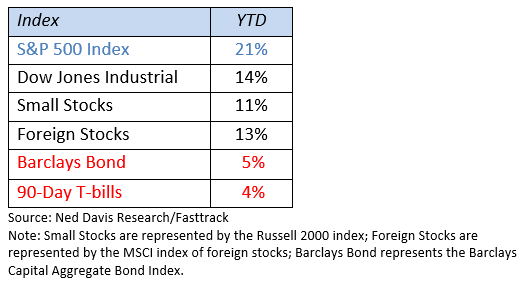Stocks continued their seemingly relentless march to greater heights in the third quarter, with the S&P 500 Index (which represents the largest U.S. companies) tacking on another 5% on top of the 15% gain already posted for the year. Unlike other recent quarters, when it seemed like only a handful of stocks were doing well, we saw a broadening of participation in the third quarter as smaller companies and foreign companies kept pace with the S&P 500 Index.
There was also a change in the leadership at the sector level. Technology and related sectors have dominated the performance charts for the past two years, but we saw a change in the third quarter, with real estate and utilities occupying the top two spots. Technology stocks actually finished the third quarter with a return barely above zero.
And what about bonds? High-quality bonds have had a rough ride over the past four years, with the return on the Barclays Aggregate Bond Index (standard benchmark for intermediate-term bonds) negative through the end of June. Since then, however, these bonds have risen strongly and finished the quarter up 5%, matching the return of stocks.

With stocks going up and bonds going up, it has been a good environment for FSA clients. Most accounts are at or near all-time highs. For the most part, accounts have been heavily allocated to stocks all year, even though we bumped up the money market allocation in late July when stocks hit a weak patch. We reinvested that money market allocation in September as stocks recovered. All in all, it has been a solid year for FSA clients up to this point.
Perspective Through Year-End
Things have gone well for stocks and bonds this year, so what are the odds they can continue on this path through year-end? Historically speaking, the odds favor a continuation of the rally. Going back to 1990, we looked at all years in which stocks returned greater than 15% in the first nine months to see how they finished in the fourth quarter. There were nine such occurrences, with no negative returns in those years. It is interesting to note that the one year with a zero percent return was the election year of 2012. Also, lest these stats make you too bullish, in 1987 stocks had a strong start to the year, and then we witnessed the Market Crash of 1987 in which stocks plunged 23% in one day.
So, while there are no guarantees in investing, the odds right now look pretty good, and this data bodes well for a positive finish to the year.
In addition, we are entering a historically favorable period in the year when stocks tend to do well. November, December, and January are usually three of the strongest months for stocks.
Plus, the Federal Reserve has begun lowering short-term interest rates, believing that inflation has cooled enough to do so. This process should provide a tailwind to reinvigorate the economy as well as the stock market (not that the stock market needs to be reinvigorated).
To be sure, there are some causes for concern as we enter the final quarter of the year. For one, we are in the middle of a contentious presidential campaign, with both sides arguing that democracy hangs in the balance. No doubt emotions could flare up as we get closer to election day, with a spillover to the financial markets.
Secondly, all the bullish attitudes toward stocks come from an assumption that the U.S. economy will avoid a recession. So far, the evidence points in that direction. But, if economic reports in the coming weeks and months start to bring that expectation into question, we should expect stocks to react in a negative way.
Finally, since we did not see a correction in the third quarter beyond a mild 8% pullback in July, it would not be totally surprising if stocks waited to post a more significant correction in the fourth quarter at a time when few would suspect. This is not our base case (see the study referenced above), but the market will often try to fool as many investors as possible, so we want to be vigilant about any late surprises.
Portfolio Update
Keep in mind that because we manage clients’ portfolios individually, the holdings in your specific accounts may differ somewhat from the averages.
Strategies That Employ the FSA Safety Net®
Income (Strategy 1)
Bonds of all types posted strong results for the third quarter, which pushed these portfolios to new highs. During the quarter we reduced our allocation to more defensive bond sectors and added to our high-yield and intermediate-term high-quality bond funds. Currently, the portfolios hold 40% in high-yield bond funds, almost 30% in high-quality bond funds, and 30% in more eclectic and defensive bond funds.
Income & Growth (Strategy 2)
It has been a solid year for this conservatively balanced strategy. Trading was relatively light during the quarter, although we did increase our allocation to high-yield and intermediate-term bond funds, while reducing our more defensive and eclectic bond positions. Currently, the portfolios hold 45% in stock funds with 50% in bond funds and only 5% in money markets.
Conservative Growth (Strategy 3)
During the pullback in July, we reduced the equity allocation slightly and then reinvested the extra money market in August as the market recovered. Currently, these portfolios hold 75% in equities and 20% in high-yield bond funds with only 5% in money markets.
Core Equity (Strategy 4)
We reduced our equity allocation slightly in July during the mild correction but quickly redeployed the money back into equities as they recovered in August and September. We added a small allocation to a global fund as well as a health care fund during that time. These portfolios remain essentially fully invested.
Tactical Growth (Strategy 5)
This aggressive strategy continues to participate in the strong equity rally. During the quarter, we added a utilities fund to the portfolios and made a few trades to reduce the growth allocation while increasing the allocation to value stocks. As we enter the fourth quarter, these accounts hold minimal money markets positions.
Active Strategies WITHOUT the FSA Safety Net®
Sector Rotation
This strategy continues to languish, having a difficult time getting on the right side of the market shifts from growth to value. At the October rotation, the strategy holds financial and banking sectors, along with industrials, health care, telecommunications, and real estate funds.
Global Rotation
Trading remains light in this aggressive strategy, but we made a slight shift away from growth toward the middle (between value and growth). Overall, this strategy remains invested with an emphasis on growth stocks.
Strategies That Remain Fully Invested Through ALL Market Cycles
Global Balanced
This passive portfolio of 50% stocks and 50% bonds benefited from the strong returns from small caps stocks and real estate securities, not to mention the solid returns from bonds, in particular the foreign bonds.
Global Moderate
It was a solid quarter for this portfolio, 70% stocks and 30% bonds, thanks to the broadening rally which lifted foreign, small-cap, real estate, and gold, all held in this strategy.
Global Growth
It was a strong quarter for this portfolio, 90% equities and 10% bonds. Every fund in the strategy posted positive returns for the quarter. Finally, we are seeing the benefits of diversification.
Please remember to inform your advisor of any changes in your life that might affect your investment objectives and how we manage your money.
Ronald Rough, CFA
Chief Investment Officer
Disclosures are available at www.fsawealthpartners.com/disclosures/market-update.
FSA’s current written Disclosure Brochure and Privacy Notice discussing our current advisory services and fees is available at www.fsawealthpartners.com/disclosures or by calling 301-949-7300.




